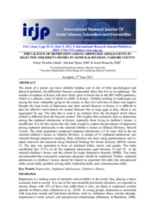Demographic Data
|
Sources: World Bank, UNICEF, UNDP HDR 2015, DHS 2011 |
Displaying 811 - 820 of 14348
The study follows the interaction between the individual and the social context regarding the development of adolescents protected in residential houses from the child protection system in Iasi County, Romania.
This paper advances the global and transnational agency approach to the study of out-of-home childcare, specifically the institutionalization of children.
This study sought to explore the prevalence of depression among orphaned adolescents in the selected children’s homes in Githurai Division, Nairobi County.
The Swedish Presidency has initiated a declaration to support the protection of Ukrainian children. The declaration will mobilise support among EU Member States for continued engagement in protecting the children who have been affected by Russia’s full-scale invasion of Ukraine.
Case studies of transformational reform programmes examined a range of approaches to the delivery of children’s services to better understand the evidence regarding systems-level integration between children’s social work/social care with health services and/or adult social care.
Strand 1: Rapid Evidence Review reviewed existing published national and international research evidence focused on better understanding the evidence associated with different models of integration of children’s services with health and/or adult social care services in high income countries, as defined by the World Bank.
This Procedure determines the mechanism of safety of the children and persons living or enlisted on the round-the-clock stay in organizations of different types, patterns of ownership and subordination (further - children and persons), during warlike situation by acceptance in case of need died to their temporary movement (evacuation), ensuring placement, proper leaving, education, and also return in the place of their permanent residence (stay), and in case of departure out of limits of Ukraine - to Ukraine.
In June 2022, hundreds of care reform leaders gathered to discuss the importance of providing adequate public financing to strengthen families and protect children in Moldova and across the globe. Conference speakers advocated for the provision of a minimum packages of services for families and children.
This study aimed to brief analyse data from the most recent SUAS census in Brazil, focusing on one of the states of the federation to verify how the referrals of children and adolescents who go through foster care are being carried out. The data showed that in certain places there is discrepancy in reintegration and adoption, the latter being the most common.
This report comprises of research into cases of historical sexual abuse that took place in the SOS Children’s Village in Suriname. This research covers roughly the period from the early seventies to 2006. The research took place partly in the Netherlands and partly in Suriname.









